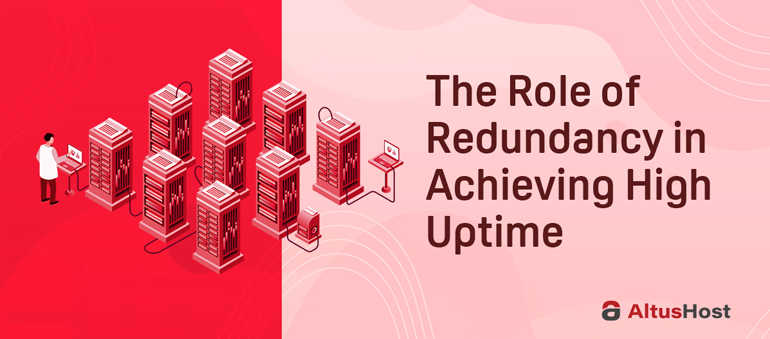In today’s technologically advanced world, businesses can’t afford any downtime. In many industries, including eCommerce, even a few minutes of downtime can cause considerable harm, like revenue losses and customer trust.
Google’s parent company, Alphabet, recently lost $100 million in revenue because its AI chatbot showcased a failure. This event led millions of its users to its competitor because of a few hours of downtime.
Fortunately, redundancy can help you avoid such a scenario. Nowadays, many businesses implement redundancy – using backup systems and components that take over if there is any system failure.
In this article, we’ll explain the role of redundancy in achieving high uptime and explore how it helps businesses maintain their operations when they face unexpected failures. But first, let’s start with why you should do your best to avoid or at least minimize downtime.
Importance of High Uptime
High uptime is crucial for the success of any business that relies on technology. By maintaining high uptime levels, your customers will be able to access your products and services at any time, which will result in creating strong customer relationships.
Also, high uptime ensures your business will continue its operations without interruptions. Furthermore, it plays a crucial role in helping companies meet compliance regulations and increase customers’ trust. Therefore, it can boost your revenue and business growth.
In contrast, downtime has a negative impact on your business operations. It causes decreased productivity, customer dissatisfaction, damage to your reputation, loss of revenue, compliance issues, and even data loss.
To avoid this, organizations invest in proactive monitoring, robust infrastructure, regular maintenance, and redundant systems. Each of these efforts minimizes the risk of downtime and ensures your service and products will be available even in unexpected circumstances, such as hardware or software failures or cyberattacks.
What Is Redundancy?
Redundancy is a system design in which you can duplicate system components to ensure continuous availability and avoid downtime.
For instance, if your system faces any failure, the backed-up components will take over, minimize downtime, and maintain crucial operations, making your system always available. In addition, as you can implement redundancy at different system levels, you can be sure you will get a high level of service availability.
Types of Redundancy
Redundancy is a standard method for achieving high uptimes in the fast-paced technology world. But if you decide to implement it in your business, you must understand that there are different types of redundancy:
- Hardware Redundancy – duplicating essential hardware components
- Software Redundancy – copying crucial software parts
- Data Redundancy – replicating data across more systems or storage devices
- Network Redundancy – making more ways for data transmission
- Power Redundancy – maintaining power sources in case of a power outage
- Geographic Redundancy – replicating data or systems across different geographic locations
Hardware Redundancy
Hardware redundancy duplicates vital hardware elements, such as hard drives, network interface cards, and power supplies. Due to this, hardware redundancy ensures that there is a backup system that is always available in case of a failure.
This redundancy type is of great importance for mission-critical systems, such as data centers, financial systems, healthcare systems, emergency report systems, and telecommunications, that require continuous operation. You can implement hardware redundancy using a few techniques, such as dual power supplies, RAID, and hot standby.
Software Redundancy
Software redundancy refers to duplicating software components or even entire applications. You can implement software redundancy in several ways, such as load balancing, failover, replication, and cluster systems. With software redundancy, you will reduce system downtime, achieve higher productivity, and minimize the risk of data loss.
It would be best to implement software redundancy for applications crucial to your business operations, like eCommerce platforms, CRM systems, ERP systems, CMS, and SaaS. Therefore, your customers will enjoy a fantastic user experience.
Data Redundancy
Data redundancy is distributing data copies across different systems or locations. More precisely, you can store your data on another storage device, server, and even another geographical location by mirroring, backups, and replication.
This redundancy type provides an extra security layer, limiting data loss, as it is much harder to gain unauthorized access to all data locations than just one. Therefore, data redundancy is best for healthcare, financial, and administrative systems.

Source: https://pixabay.com/photos/sd-card-space-backup-storage-5219484/
Network Redundancy
Network redundancy connects data to multiple network switches, cards, internet service providers, and routers. You can implement it by utilizing methods such as STP, VRRP, and LACP. This redundancy type allows easy rerouting of the network traffic to an available connection in case of failure.
Additionally, network traffic spreads faster and easier, which reduces network latency. Also, it will significantly help you in improving network security. Due to having different connections and traffic ways, hackers won’t gain unauthorized access to sensitive data so easily. That’s why network redundancy is most suitable for finance, healthcare, and manufacturing mission-critical systems.
By purchasing some of our AltusHost remote backup plans, you can enjoy continuous data protection, a central backup repository, full bare-metal restore, top-quality hardware, and an innovative web interface. All of these perks will take care of providing high uptimes and securing your sensitive data.

Source: https://www.altushost.com/remote-backups/
Power Redundancy
Power redundancy refers to powering the server in the event of a power outage. You can use the backup generators, UPS, and PDUs methods to implement this type of redundancy and ensure service availability.
Furthermore, by providing a continuous power supply, power redundancy minimizes downtimes and the risk of system failures. It also prevents data loss and reputational damage. Due to this, power redundancy is crucial for servers in data centers, hospitals, financial institutions, and eCommerce platforms.
At AltusHost, we offer you dual power supplies, which are capable of powering the entire server on their own. If you require additional redundancy, you can benefit from A/B power, which plugs each power supply into a different circuit breaker. You can even extend it further by connecting the power supplies to UPS units.
Geographic Redundancy
Geographic redundancy refers to distributing crucial system components or infrastructures across multiple data centers in different geographic locations. You can implement this redundancy type using techniques like cloud-based disaster recovery, active-active data centers, and active-passive data centers.
For example, if your server fails or there is a natural disaster affecting one data center, the work will switch to some alternate locations without disrupting your services. Therefore, the geographic redundancy type is best for financial systems, healthcare systems, and other mission-critical applications like eCommerce platforms.
At AltusHost, we allow you to get remote backups with an additional level of security that will store your data on our strong Storage Servers, which are located in the Netherlands.

Source: https://www.altushost.com/remote-backups/
Best Practices for Implementing Redundancy
Redundancy requires careful planning, as it can affect your business negatively if duplication is unnecessary. It can increase expenses, complexity, and maintenance costs, harming operating efficiency.
To ensure that the redundancy remains effective and meets the needs of your business over time, you should follow the best practices.
Identify Redundancy Needs
Before you do anything, you must determine the redundancy needs for your system. To do this, you should consider criteria like your budget limit, uptime, risk tolerance, and operational needs. Then, you should evaluate the level of redundancy required for each depending on its relevance, the potential consequence of downtime, and any regulatory or compliance requirements.
If you are a beginner, it would be best to leave this to a professional to get the right redundancy, which will be cost-effective and fulfill all your business needs.
Develop a Redundancy Strategy
Developing a redundancy strategy entails identifying mission-critical systems, data, and applications and assessing their potential failure scenarios.
You should evaluate all potential failure scenarios so that you can determine the right level of redundancy needed to minimize downtime and maintain operations. Furthermore, you must consider complexity, costs, and effectiveness, which will help you ensure you have a strategy that fulfills your business goals.
In addition, conducting regular reviews and updates of the strategy ensures its ongoing relevance and adaptability to changing needs and technologies.
Implement Redundancy at Multiple Levels
Implementing redundancy at multiple levels is crucial for the durability of the system infrastructure. It refers to duplicating critical components across different levels, like hardware, software, and network.
Organizations can utilize various approaches to incorporate redundancy at multiple levels, including using redundant hardware components, implementing load balancing and failover mechanisms in software, and designing network infrastructure with redundant connections and paths.
By doing so, organizations can minimize single points of failure and protect against unexpected outages. Redundancy also allows for more efficient fault detection and recovery, as problems can be isolated and resolved without affecting the entire system.
Use Diverse Redundant Techniques
To balance complexity, costs, and effectiveness during redundancy planning, you should utilize diverse redundant techniques. For example, you can employ load balancing, data replication, failover, and clustering, which will make sure your systems are highly available all of the time.
Employing a diverse set of redundant techniques will help you create a robust and flexible redundancy strategy, providing a higher level of protection and ensuring uninterrupted operations for your business.
Check Redundancy Scalability
Scalability is necessary, as it allows your business to grow and keep up with traffic or requirement changes over time.
It would be best to estimate the growth of your business, so you can choose the right redundancy solution that will keep up with the future risks of failure. Also, you can consider utilizing other redundancy components, such as network devices, storage devices, and servers, that you can easily add to your existing system.
Monitor and Test the Redundancy Solution
You must constantly monitor and test your redundancy measures to ensure they can effectively handle failover scenarios. To conduct the testing, you can install monitoring tools that will allow you to track your system’s performance, network connection, and hardware status.
That way, you will be able to detect issues before they harm your system and resolve them proactively.

Source: https://pixabay.com/illustrations/problem-problem-solution-solution-98377/
Final Thoughts
Redundancy guarantees your crucial operations will go on issue-free and without any interruptions. As a result, you will achieve high uptimes, and your customers will have a flawless user experience.
So, investing in redundancy is a good choice that will help you stay ahead of the curve and provide highly-effective operations, no matter whether you are a small or a large business. The only thing you need to do is to consider the best practice ways for implementation and choose the best redundancy type that will fit your needs, and high uptime will be guaranteed!



